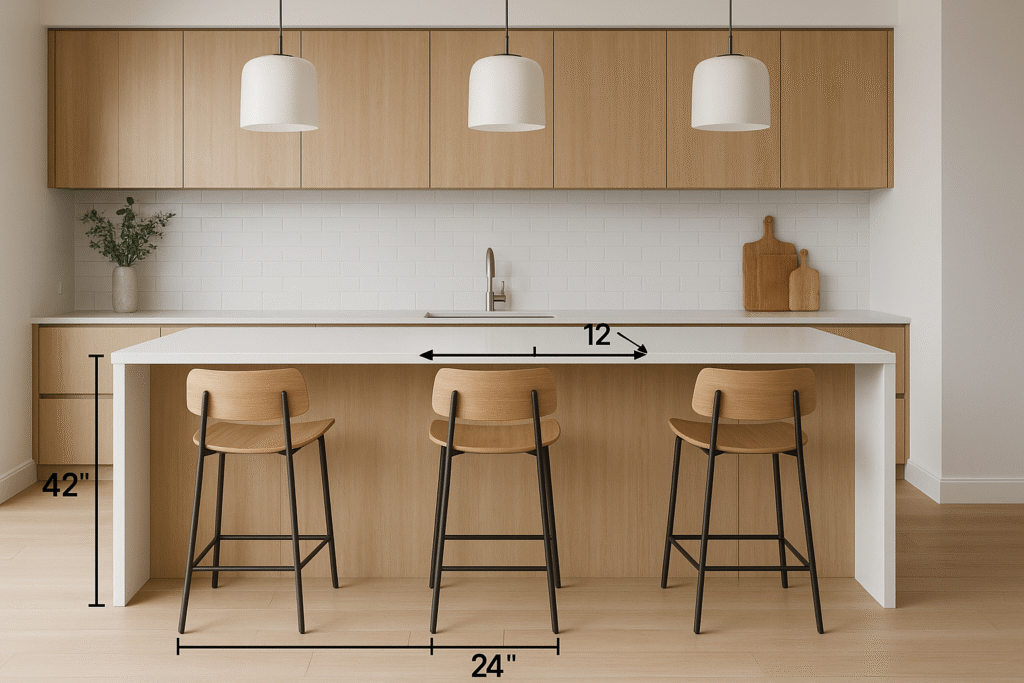A breakfast bar isn’t just a piece of furniture—it’s a hub for casual meals, family chats, homework sessions, and even a home office space.
But the functionality of a breakfast bar depends heavily on getting the dimensions right.
Choosing the wrong size can lead to cramped seating, awkward movement, or inefficient use of space.
Whether you’re working with a compact galley kitchen or a spacious open-plan layout, understanding the breakfast bar size that suits your space and lifestyle is essential.

Quick Reference: Standard Breakfast Bar Dimensions
Here’s a quick snapshot of the standard kitchen breakfast bar dimensions used in most homes.
These measurements provide a solid starting point before you adjust based on your needs:
| Feature | Standard Measurement |
|---|---|
| Average Breakfast Bar Height | 42 inches |
| Table Height Bar | 30 inches |
| Counter Height Bar | 36 inches |
| Breakfast Bar Overhang Depth | 10–12 inches |
| Width for 2-Person Seating | 48 inches minimum |
| Depth of Breakfast Countertop | 24–30 inches |
These standards are ideal for most kitchens, but they can be customized depending on your available space, number of users, and style preferences.
📌Related Read: 03 Best Drop Leaf Breakfast Tables on Amazon
Choosing the Right Breakfast Bar Height
The height of your breakfast bar significantly affects comfort, stool choice, and how well it integrates with other kitchen elements.
➤ Common Height Options:
- 30 inches (Table Height): Ideal for casual dining; pairs with standard chairs.
- 36 inches (Counter Height): Matches most kitchen countertops.
- 42 inches (Bar Height): The most popular breakfast bar height, perfect for bar stools and elevated seating.
➤ When to Choose What:
- If you’re integrating your bar with existing countertops, match the height (typically 36”).
- For a more casual and cozy feel, a table-height breakfast bar works well in small spaces.
- Want a distinct eating area? A 42-inch bar height offers a clear separation between prep and dining zones.
Keyword Tip: This section targets breakfast bar height, table height breakfast bar dimensions, and average breakfast bar height.
How Deep Should a Breakfast Bar Overhang Be?
A frequently asked question is:
How much overhang should a breakfast bar have for seating?
➤ Standard Overhang Depth:
- 10 to 12 inches is the typical range.
- 8 inches is the minimum if you’re short on space, but only works with backless stools or tight seating.
- 15 inches provides more legroom for deep stools or extra comfort.
➤ Overhang Tips:
- Support is crucial. Overhangs beyond 12 inches may need brackets or legs for stability.
- Always consider the stool depth and knee clearance when finalizing the overhang.
Ideal Width of Breakfast Counters by Seating Capacity
The width of your breakfast bar directly relates to how many people it can seat comfortably.
A simple rule of thumb is to allow 24 inches of width per person.
➤ Recommended Widths:
- 2 seats → 48 inches wide
- 3 seats → 72 inches wide
- 4 seats → 96 inches wide
If you’re placing stools side-by-side, ensure there’s enough room to slide them in and out without bumping into one another or the bar edges.
➤ Width for Couples:
For two-person seating, a 48-inch wide bar works great, especially in compact kitchens.
It offers just enough space for two people to sit comfortably side by side without feeling cramped.
Keywords targeted: width of breakfast counter for 2 seating, how wide is a breakfast bar
Depth and Overall Size of a Breakfast Countertop
The depth of your breakfast bar not only affects how it looks but also how useful it is.
➤ Standard Depth:
- 24 to 30 inches is the ideal depth for a functional breakfast bar.
- For smaller kitchens, a bar as shallow as 16 inches can still offer usable space without overwhelming the room.
➤ Considerations:
- Add depth if you’re incorporating storage or appliances beneath.
- For custom builds, make sure the depth aligns with your cabinetry and leaves enough knee clearance under the overhang.
➤ Compact Layout Tip:
In tight spaces, opt for a narrower bar (e.g., 18–20 inches deep) with tucked-in stools to maximize walkways and functionality.
How to Measure for a Custom-Built Breakfast Bar
If you’re planning a custom breakfast bar, proper measurements ensure it fits seamlessly with your kitchen layout and daily habits.
✔ Step-by-Step Guide:
1. Measure Available Floor Space
- Measure the total length and width where the bar will sit.
- Leave at least 36–42 inches of clearance for walking space behind stools.
2. Account for Seating
- Plan for 24 inches of width per person.
- For 3 seats, you’ll need a minimum of 72 inches (6 feet).
3. Consider Bar Overhang Support
- For overhangs over 12 inches, add brackets or corbels to avoid sagging.
4. Decide on Functionality
- Want built-in appliances or cabinets? Add 6–12 inches more depth.
- Add outlets if you’ll be using laptops or appliances.
📝 Tip: Use painter’s tape on the floor to map out your bar before committing.
Ideal Breakfast Bar Size for Families 👨👩👧👦
A family-friendly breakfast bar should be spacious, safe, and practical for both kids and adults.
What to Consider:
- Seating for 4 or more: Opt for at least 8 feet (96 inches) in length.
- Rounded corners: Reduce sharp edges if children are present.
- Easy-clean surfaces: Quartz, laminate, or sealed wood are low-maintenance.
Suggested Dimensions:
- Height: 36 or 42 inches
- Width: 96 inches for 4–5 people
- Depth: 24–30 inches
- Overhang: 12–15 inches for comfortable legroom
Planning Your Space: Layout & Clearance Guidelines
When installing a breakfast bar, spacing is everything.
It not only impacts comfort but also determines how smoothly people can move around the kitchen.
Space Guidelines:
- Behind bar stools: Leave 36–48 inches for easy passage, especially in high-traffic kitchens.
- Between stools: Leave at least 6 inches (or 12–15 cm) for elbow room and ease of seating.
- Against walls or cabinets: Keep at least 36 inches of clearance to open drawers or walk comfortably.
💡 Planning for clearance now saves frustration later when moving stools or hosting guests.
Standard vs. Custom-Built Breakfast Bars
When Should You Go Custom?
Standard breakfast bars work well in most kitchens, but custom-built bars are perfect if you:
- Have an uneven layout
- Want to include built-in appliances
- Need extra storage
- Have a compact kitchen or an awkward corner
✅ Custom Planning Checklist:
- 🔲 Do you need appliances built in?
- 🔲 Will the bar provide storage?
- 🔲 How many people will use it daily?
- 🔲 Is your kitchen space limited or irregular?
🧠 Custom breakfast bars let you design around your lifestyle—not the other way around.
Kitchen Breakfast Bar – FAQs
A standard breakfast bar is typically 42 inches high, 24 to 30 inches deep, and should offer at least 24 inches of width per person for comfortable seating.
The overhang should be between 10 to 15 inches, depending on your stool height and how much legroom you want for comfort.
The ideal height for most breakfast bars is 42 inches, which works well with standard bar stools and fits most kitchen layouts.
Yes, a 10-inch overhang is generally enough for backless stools, but a 12- to 15-inch overhang provides extra comfort and legroom.
Allow at least 24 inches of width for each stool, and leave 6 to 12 inches of space between stools to prevent crowding.
Absolutely! You can extend your kitchen worktop with a sturdy overhang to create a functional breakfast bar.
The minimum size for a breakfast bar that seats two people comfortably is 48 inches wide and 24 inches deep.
Final Thoughts
A breakfast bar is more than a trendy addition—it’s a practical space for meals, chats, and multitasking.
Whether you’re building from scratch or modifying an existing island, accurate measurements and clear planning can save you costly regrets later.
👉 Custom-fit your bar to your lifestyle, from family size to storage needs to traffic flow.
That’s the secret to a breakfast bar that truly works.
📌Related Reading
03 Best Drop Leaf Breakfast Tables on Amazon
Small Kitchen Table Dimensions
Average Size Of Kitchen Countertop
How to Choose the Right Bar Stools
